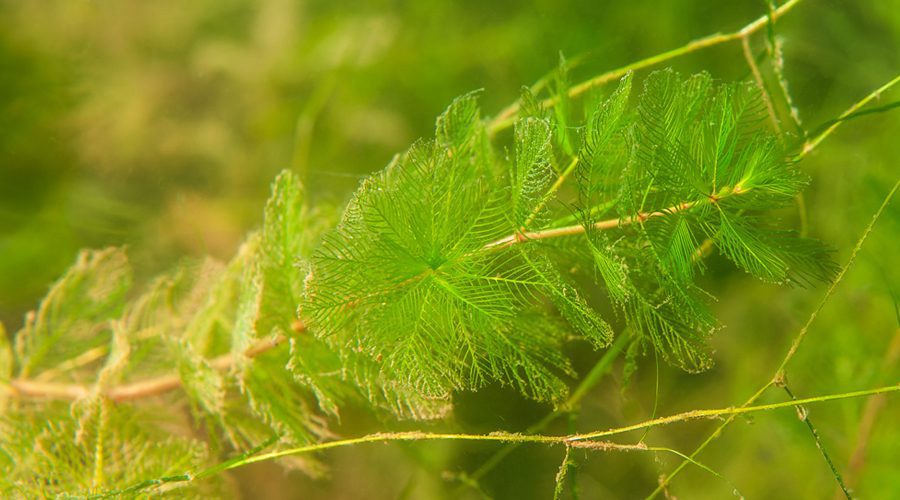LCRA announces new schedule, rebates for managing invasive aquatic vegetation on lakes Inks, LBJ and Marble Falls
New schedule limits treatments to specific weeks to consolidate efforts
APRIL 1, 2024

The programs are:
- A new treatment zone schedule to consolidate efforts of lakeside property owners wanting to remove or treat nuisance aquatic vegetation on Inks Lake, Lake LBJ and Lake Marble Falls. The program divides property on the three lakes into separate zones and limits application of herbicides to specific time periods.
- A rebate program offering up to 50% of the project cost, to a maximum of $7,500 per applicant, for municipalities, counties and homeowners/property owners associations that manage invasive aquatic vegetation on Inks Lake, Lake LBJ or Lake Marble Falls.
All management plans must be approved by the Texas Parks and Wildlife Department and LCRA before being implemented.
LCRA manages hydrilla and water hyacinth on the Highland Lakes when the plants have the potential to impact LCRA dam or power plant operations. LCRA does not manage Eurasian watermilfoil and other vegetation that does not pose a threat to LCRA infrastructure operations.
New treatment zones
The new treatment schedule divides property along Inks Lake, Lake LBJ and Lake Marble Falls into zones, with each zone having three designated periods when herbicide treatments may be applied to aquatic vegetation.
“The new schedule is designed to coordinate efforts, make treatments more effective and help others know when herbicides may be in the water near their property,” said John Hofmann, LCRA executive vice president of Water.
Treatment plans must first be approved by TPWD and LCRA. The zone map, as well as a treatment proposal form, a list of approved herbicide ingredients and more information, is available at www.lcra.org/waterweeds.
LCRA strongly recommends contacting a licensed applicator to design and implement a treatment plan for any herbicide applications. A list of licensed herbicide applicators and aquatic plant management companies is available at https://aquaplant.tamu.edu/applicators/.
Before an herbicide is used, the applicator must provide notice at least 14 days in advance to all public water intakes within 2 river miles of the treatment site and all individuals on the TPWD herbicide use notification list. See www.lcra.org/waterweeds for a full list of required notifications.
Property owners on Lake Buchanan and Lake Travis may remove or treat nuisance aquatic vegetation at any time, provided they have a treatment plan approved by TPWD and LCRA.
The City of Austin has jurisdiction over Lake Austin and any vegetation management there in coordination with TPWD.
Rebate program
LCRA is offering rebates to municipalities, counties and homeowners/property owners associations of up to 50% of the project cost, to a maximum of $7,500 per applicant, for removal or treatment of invasive aquatic vegetation on Inks Lake, Lake LBJ or Lake Marble Falls. To qualify for a rebate, chemical (herbicide) treatments must occur during the treatment zone schedule periods, and physical (manual and/or mechanical) removal must occur between April 17 and Aug. 31, 2024. The deadline to submit rebate applications is Sept. 15, 2024.
LCRA will issue rebates after the Sept. 15 application deadline, and cautions that rebates may be less than 50% of the project cost, depending on the total number of applications submitted and rebate amounts requested.
LCRA recommends that invasive aquatic plants be physically removed rather than treated with herbicides. Plants that are treated with herbicides can decompose and turn into a nutrient source for other plants and algae to grow in the same area.
To qualify for a rebate, an applicant must:
- Be a lakeside property owners association or homeowners association, or a governmental entity such as a city or county.
- Conduct the management on Inks Lake, Lake LBJ or Lake Marble Falls during the treatment zone schedule periods for chemical (herbicide) treatment, or between April 17 and Aug. 31, 2024, for physical (manual and/or mechanical) removal. Any herbicide must be applied by a licensed aquatic herbicide applicator.
- Use a treatment plan that has been approved by TPWD and LCRA as described in the State Aquatic Vegetation Plan. The TPWD Aquatic Vegetation Management Guidance Document is available online at www.tpwd.texas.gov/publications/pwdpubs/media/pwd_pl_t3200_1066.pdf.
- Submit an application, itemized receipt of the work and proof of TPWD approval of the treatment plan to LCRA by Sept. 15, 2024.
Detailed rules and the application are available at www.lcra.org/waterweeds. For additional information or to discuss a specific treatment proposal, email [email protected].
Reducing the amount of nutrients entering the lakes is the best long-term strategy to manage nuisance aquatic plants and algae. Nutrient sources include leaves, grass clippings, fertilizers, animal droppings, fish food, food scraps and other organic matter. Keeping these items out of the lakes helps protect water quality.
About LCRA
The Lower Colorado River Authority serves customers and communities throughout Texas by managing the lower Colorado River; generating and transmitting electric power; providing a clean, reliable water supply; and offering outdoor adventures at more than 40 parks along the Colorado River from the Texas Hill Country to the Gulf Coast. LCRA and its employees are committed to fulfilling our mission to enhance the quality of life of the Texans we serve through water stewardship, energy and community service. LCRA was created by the Texas Legislature in 1934 and receives no state appropriations.


Social Media